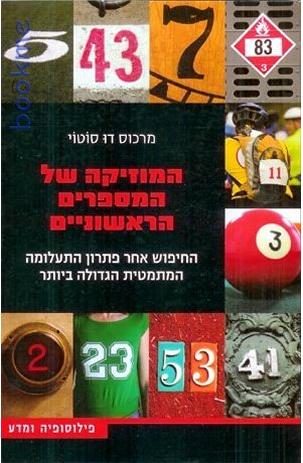Marcus Du Sotoy's book The Music of the Prime Numbers - The Search for the Solution of the Greatest Mathematical Mystery, translated by Uriel Givon, was published by Elit HaGeg Books, Yedioth Ahronoth and Seferi Hamad.
Avi Blizovsky

Marcus Du Sotoy's book The Music of the Prime Numbers - The Search for the Solution of the Greatest Mathematical Mystery, translated by Uriel Givon, was published by Elit HaGeg Books, Yedioth Ahronoth and Seferi Hamad.
The hero of the book is the German mathematician Bernard Riemann, who proposed a hypothesis to solve the ancient riddle: how can one determine when the next prime number will appear? Is there legality and order in the appearance of the initial numbers? And why is it so important? Sotoi tells the story of the brilliant and strange man whose influence reaches to this day in different and varied fields: quantum mechanics, cryptography, computer science and more. It is also the story of the immortal enigma about the multitude of brilliant and often the strangest characters who have struggled with it from then until these days and could not.
Riemann was a contemporary of Cauchy Langrange and Abel and in his doctorate, which he submitted to the famous mathematician Gauss, he provided ideas about geometry and its relation to physics, ideas that developed during his work with Weber. Riemann was convinced that fundamental questions in physics could be answered using only mathematics. The development in physics over the following years would eventually confirm his faith in mathematics. Riemann's geometric theory is considered by many to be one of his greatest contributions to science, and it will be one of the springboards from which Einstein will launch his scientific revolution at the beginning of the twentieth century.
Riemann compared the prime numbers to music, which is not just a random collection of notes here and there arranged across the fifth. Rieman died at the age of 39 from tuberculosis, and his zealous housekeeper burned many of the documents he left behind, this is perhaps part of the reason that even things he proved remained unproven and therefore his hypothesis which he wrote seven years before his death remained a hypothesis.
Here are some excerpts from the introduction to the book, we brought the story of the cicadas on the Hidan website, and Aryeh Seter's article is attached at the end of the review.
Du Sottoy writes: "Nature is full of references to mathematical methods that man only discovered much later, for example Fibonacci discovered the series that bears his name when he observed the reproductive habits of rabbits - his model of rabbit reproduction predicted that in each new season the number of pairs of rabbits would increase according to a certain pattern. This pattern was based on two rules: each pair of rabbits would give birth to a new pair of rabbits each season, and each new pair of rabbits would have one season to reach sexual maturity. It turns out that Fibonacci numbers appear in different forms - in the number of petals in a flower, in the number of spirals in a pine cone, in the growth of a seashell over time, and more."
"The formula by which Fibonacci numbers are created is based on a certain number called the "golden ratio" (golden section), a number starting with 1.61803 and so on. The decimal development of the golden ratio continues until without any pattern, like the number Pi. However, it has what many people throughout history have seen as perfect proportion. If you examine the paintings in the Louvre Museum in Paris or the Tay Gallery in London, you will find that the artist often chose a rectangular shape, the ratio between its sides is 1 to 1.61803... The experiment reveals that a person's height compared to the distance between his feet and his navel tends to maintain the same ratio. The Nth Fibonacci number can be expressed by a formula containing the Nth power of the golden ratio." ….
"Not only Fibonacci numbers are found in nature. The animal kingdom also knows about prime numbers. There are two species of crickets (cicadas) called Majicida septandissim and Orchards, which often live in the same environment. Their life expectancy is exactly 17 years one, and 13 years the other. In all their years except the last, they remain on the ground, feeding on the pulp of tree roots. Then in their last year, they are transformed from cocoons to full adults and emerge together from the earth. This is an unusual event, because every 17 years the H. species takes over. Spatands over the entire forest for one night. They chirp loudly, mate, eat, lay eggs and die six weeks later. The forest falls silent for another 17 years."
"But why did each species choose an initial number of years as the length of its life? First, they will appear together in the same year only once every 221 years, compared to more times if they appeared every non-prime number of years. The initial numbers 13 and 17, on the other hand, allow both species of crickets to avoid unnecessary competition. Another explanation is that a fungus evolved that appeared at the same time as the crickets. The fungus is poisonous to crickets, so they developed a life cycle that would keep them away from it.... For the crickets, the prime numbers were not just an abstract curiosity but a key to survival.”
